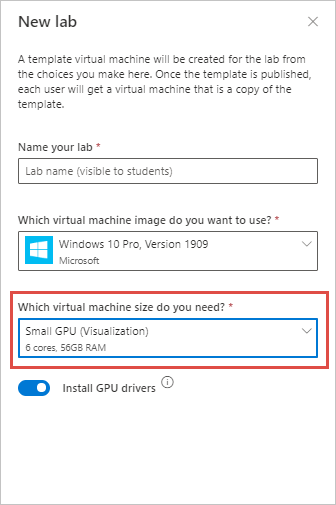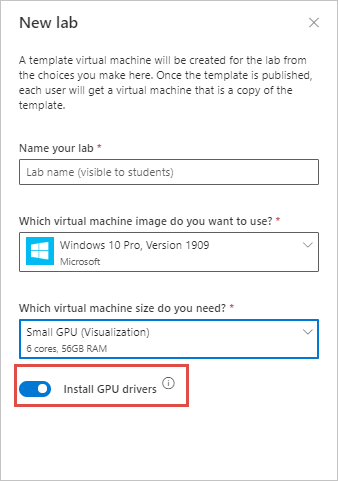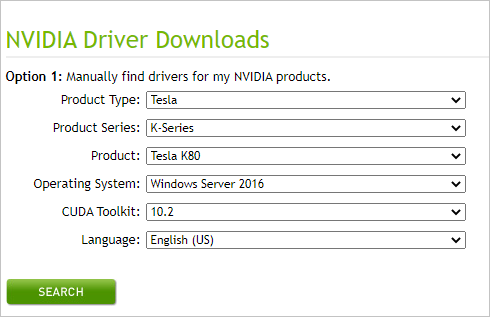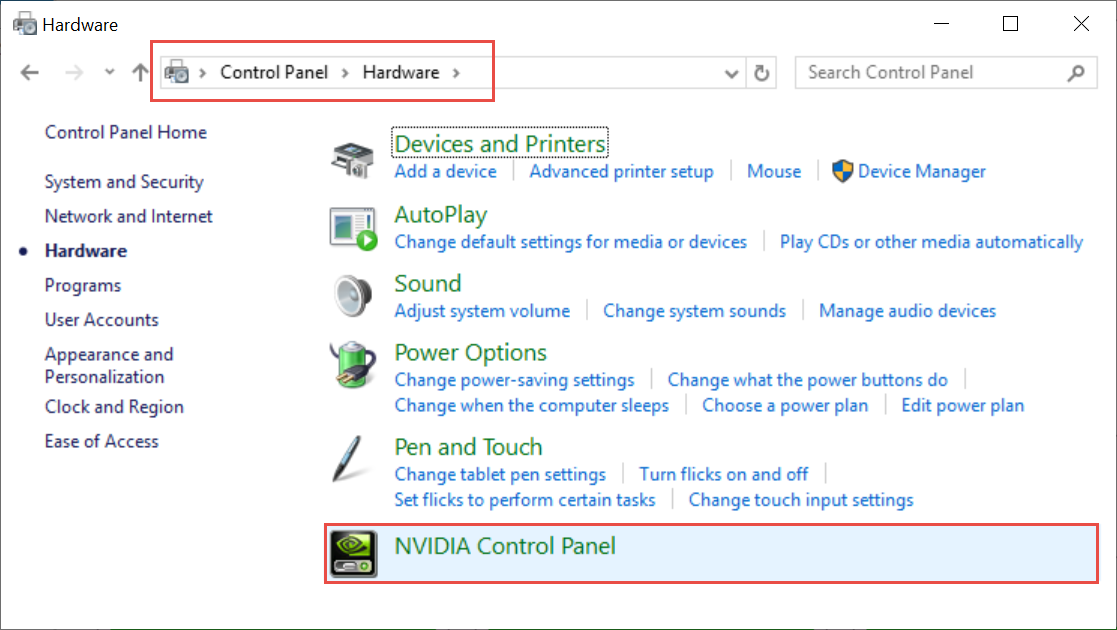Note
Access to this page requires authorization. You can try signing in or changing directories.
Access to this page requires authorization. You can try changing directories.
Important
Azure Lab Services will be retired on June 28, 2027. For more information, see the retirement guide.
Important
The information in this article applies to lab accounts. Azure Lab Services lab plans replace lab accounts. Learn how you can get started by creating a lab plan. For existing lab account customers, we recommend that you migrate from lab accounts to lab plans.
This article shows you how to do the following tasks:
- Choose between visualization and compute graphics processing units (GPUs).
- Ensure that the appropriate GPU drivers are installed.
Choose between visualization and compute GPU sizes
On the first page of the lab creation wizard, in the Which virtual machine size do you need? drop-down list, you select the size of the VMs that are needed for your class.

In this process, you have the option of selecting either Visualization or Compute GPUs. It's important to choose the type of GPU that's based on the software that your students will use.
The compute GPU size is intended for compute-intensive applications.
| Size | vCPUs | Memory (GB) | Series | Suggested use | GPU/Accelerator | Accelerator Memory (GB) |
|---|---|---|---|---|---|---|
| Small GPU (Compute) | 8 | 56 | NC8asT4_v3 | Computer-intensive applications like AI and deep learning | NVIDIA Tesla T4 | 16 |
| 6 | 112 | NC6s_v3 | Computer-intensive applications like AI and deep learning | NVIDIA Tesla V100 | 16 |
The visualization GPU sizes are intended for graphics-intensive applications.
| Size | vCPUs | Memory (GB) | Series | Suggested use | GPU/Accelerator | Accelerator Memory (GB) |
|---|---|---|---|---|---|---|
| Small GPU (Visualization) | 12 | 110 | NV12ads_A10_v5 | Remote visualization,and streaming | NVIDIA A10 (1/3) | 8 |
| Medium GPU (Visualization) | 18 | 220 | NV18ads_A10_v5 | Remote visualization and streaming | NVIDIA A10 (1/2) | 12 |
| 12 | 112 | NV12_v3 | Remote visualization and streaming | NVIDIA Tesla M60 | 8 |
Note
You may not see some of these VM sizes in the list when creating a lab. The list is populated based on the current capacity of the lab's location. For availability of VMs, see Products available by region.
Ensure that the appropriate GPU drivers are installed
To take advantage of the GPU capabilities of your lab VMs, ensure that the appropriate GPU drivers are installed. In the lab creation wizard, when you select a GPU VM size, you can select the Install GPU drivers option.

The GPU driver option is enabled by default, which will install recently released drivers for the type of GPU and image that you selected.
- When you select a visualization GPU size, your lab VMs are powered by the NVIDIA Tesla M60 GPU and GRID technology. In this case, recent GRID drivers are installed, which enables the use of graphics-intensive applications.
Important
The Install GPU drivers option only installs the drivers when they aren't present on your lab's image. For example, the GPU drivers are already installed on the Azure marketplace's Data Science image. If you create a lab using the Data Science image and choose to Install GPU drivers, the drivers won't be updated to a more recent version. To update the drivers, you will need to manually install them as explained in the next section.
Install the drivers manually
You might need to install a different version of the drivers than the version that Azure Lab Services installs for you. This section shows how to manually install the appropriate drivers, depending on whether you're using a compute GPU or a visualization GPU.
Install the compute GPU drivers
To manually install drivers for the compute GPU size, by doing the following steps:
In the lab creation wizard, when you're creating your lab, disable the Install GPU drivers setting.
After your lab is created, connect to the template VM to install the appropriate drivers.

a. In a browser, go to the NVIDIA Driver Downloads page.
b. Set the Product Type to Tesla.
c. Set the Product Series to K-Series.
d. Set the Operating System according to the type of base image you selected when you created your lab.
e. Set the CUDA Toolkit to the version of CUDA driver that you need.
f. Select Search to look for your drivers.
g. Select Download to download the installer.
h. Run the installer so that the drivers are installed on the template VM.Validate that the drivers are installed correctly by following the instructions in the Validate the installed drivers section.
After you've installed the drivers and other software that are required for your class, select Publish to create your students' VMs.
Note
If you're using a Linux image, after you've downloaded the installer, install the drivers by following the instructions in Install CUDA drivers on Linux.
Install the visualization GPU drivers
To manually install drivers for the visualization GPU sizes, follow these steps:
In the lab creation wizard, when you're creating your lab, disable the Install GPU drivers setting.
After your lab is created, connect to the template VM to install the appropriate drivers.
Install the GRID drivers that are provided by Microsoft on the template VM by following the instructions for your operating system:
Restart the template VM.
Validate that the drivers are installed correctly by following the instructions in the Validate the installed drivers section.
After you've installed the drivers and other software that are required for your class, select Publish to create your students' VMs.
Validate the installed drivers
This section describes how to validate that your GPU drivers are properly installed.
Windows images
- Follow the instructions in the "Verify driver installation" section of Install NVIDIA GPU drivers on N-series VMs running Windows.
- If you're using a visualization GPU, you can also:
View and adjust your GPU settings in the NVIDIA Control Panel. To do so, in Windows Control Panel, select Hardware, and then select NVIDIA Control Panel.

View your GPU performance by using Task Manager. To do so, select the Performance tab, and then select the GPU option.

Important
The NVIDIA Control Panel settings can be accessed only for visualization GPUs. If you attempt to open the NVIDIA Control Panel for a compute GPU, you'll get the following error: "NVIDIA Display settings are not available. You are not currently using a display attached to an NVIDIA GPU." Similarly, the GPU performance information in Task Manager is provided only for visualization GPUs.
Depending on your scenario, you may also need to do additional validation to ensure the GPU is properly configured.
Linux images
Follow the instructions in the "Verify driver installation" section of Install NVIDIA GPU drivers on N-series VMs running Linux.
Next steps
See the following articles: